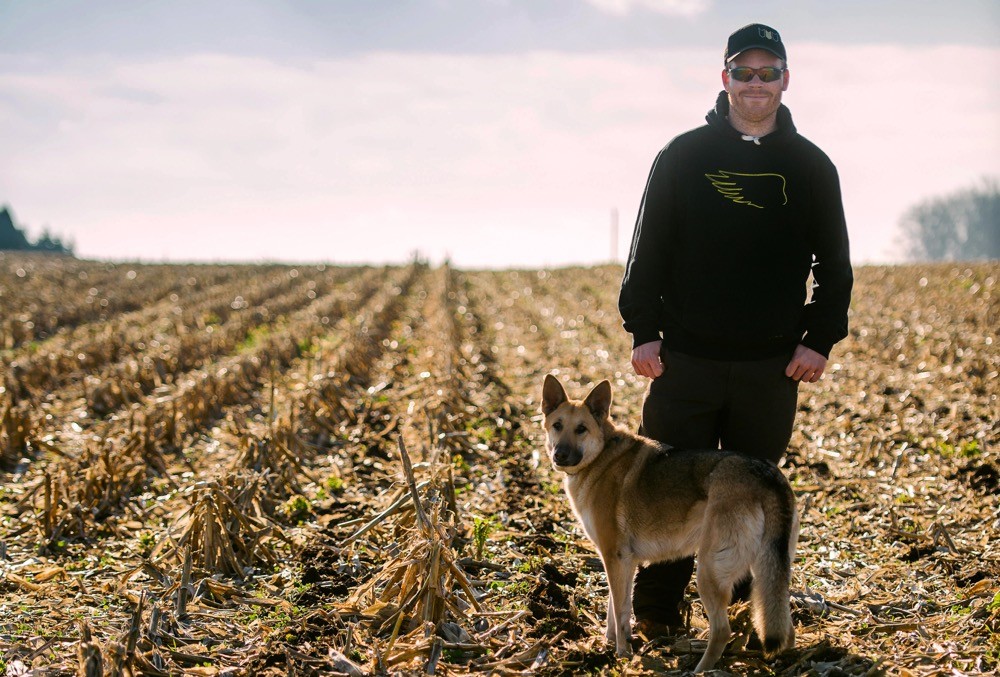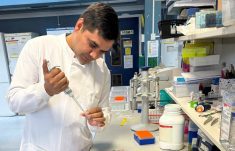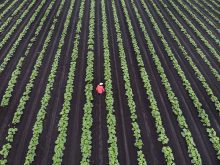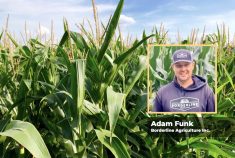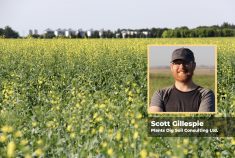Change may be inevitable, but that doesn’t mean it’s always welcome. On the farm, in fact, there are times when change can be greeted with suspicion, reluctance and sometimes even with disdain.
Then there’s Tyler Vollmershausen, a sixth-generation farmer who works with his father Larry, his uncle Brian and his grandparents Doug and Connie on Vollmershausen Farms near Innerkip, north-east of Woodstock, Ont.
It was only a few years ago that Tyler was considering a career outside agriculture. He was looking at something different, perhaps in engineering. Then he joined the family operation and began attending workshops, seminars and gatherings like the Southwest Agricultural Conference and SoilSmart.
It was during one of those meetings that he first heard from a person who has become an inspiration on his family’s farm.
“Three years ago, I listened to a guest speaker who completely changed the way I view agriculture,” Vollmershausen, recalls, citing a presentation by Dr. Jill Clapperton.
Clapperton worked for 16 years with Agriculture and Agri-Food Canada in Lethbridge, Alta., before moving to the Montana ranch of her husband’s family several years ago. Then in 2011, she co-founded Rhizoterra, based in Reardon, Wash., and she continues to work on soil health issues.

Vollmershausen was intrigued as Clapperton spoke about the soil food web, and about cover crops and biomimicry. He spoke with Clapperton after the session, giving her a brief description of his cropping practices, and she convinced him that the road to establishing better soil health on their farm would come from abandoning plowing and unnecessary tillage.
Back home, it was relatively easier to convince his father than his grandfather that this would be the right way to go, but the results are already becoming visible, and they are definitely encouraging.
Vollmershausen has posted photos on Twitter of a patch of one field where little used to grow (he actually referred to it as “bald patch”). It’s been one of his reclamation projects, and sported a healthy stand of corn last summer.
Read Also

Producers aren’t panicking over tariffs and trade threats
The influence of tariff and trade uncertainity on farm business decisions.
Vollmershausen gives credit to Clapperton’s theoretical approach.
“She explained with great clarity how we can use agriculture to integrate with natural patterns,” he says. “In order to accomplish this, we need to stimulate soil biology by bringing biodiversity back to our soils and maintaining living plant roots at all times.”
“It makes sense,” he says. “This is how soil was meant to function — and it works.”
Vollmershausen has also been delving into the world of mycorrhizal fungi, trying to understand more of the fundamentals of soil health, and he uses a catchphrase on Twitter: “The more I learn about soil, the less I treat it like dirt.”
On the farm
Since that epiphany, Vollmershausen has moved the family farming operation to a strip-till/no-till/cover-crop system that gets the most out of their rotation of corn and dry beans followed by a winter cereal, either wheat, oats or rye.
But a farm has to be sustainable economically too, so the family tries to be flexible with rotations to react to market opportunities, sometimes shortening their rotation to corn and beans or even continuous corn. What doesn’t change, however, is their commitment to improving their soils, for instance with strip tilling and the GreenSeeker technology the family has used for two years.
“We strip till both our corn and dry beans,” he says. “Our strip tiller is a Soil Warrior, which is a fall (deep) and/or spring (shallow) pass system. The majority of our soils are light-textured, and only require a single spring pass ahead of planting.”
The family incorporated the Green-Seeker technology believing it would comple-ment the strip-till system as they moved their focus towards improving the overall soil health, which they’re addressing via nutrient cycling with cover crops and by limiting soil disturbance.
“GreenSeeker gives us the ability to fine-tune nitrogen rates with later or multiple applications, and to take advantage of what the soil is supplying naturally,” says Vollmershausen. “We also integrated several precision agriculture technologies into our operation to improve efficiencies and limit production costs: RTK guidance, swath control on the sprayer, individual row clutching and automated row-unit down-force on the planter, high-resolution soil mapping (SoilOptix) for variable-rate lime applications and variable-rate seed and fertilizer prescriptions. We’re also keeping a close eye on the development of multi-hybrid planter technology which we think would be a profitable fit for our variable soil types.”
The majority of the farming operation’s crop planning is done during the winter months. There’s always a general template that they follow, but there’s also some fine tuning to be done in winter. As the complexity of their systems and their goals for both their cropping system and their soils have increased, Vollmershausen has turned to a third-party advisory company, Premier Crop Systems, based out of Iowa, to help make management zone decisions and analyze their data.

At the same time, Vollmer-shausen can often be seen scouting his fields with his iPad in hand. Between the advisory service and his own observations, it gives the family the confidence to move forward and build a better understanding of what works best on their farming operation.
“And last year, we’ve learned that our soil health strategies are paying off,” he says, noting that 2015 was the most severe drought his family has experienced in decades. Farms within a few miles received timely rains but the Vollmer-shausen operation saw far less, yet any damage was mitigated due to many of the practices put in place. “It was all about creating a soil environment that allowed the crop to root deeply, without restrictions, and to maximize moisture retention. Also, our variable-rate seed prescriptions helped to decrease plant stress.”
Think of a corn plant as a water pump, says Vollmer-shausen. What he tries to do is to match the right plant population to the water-holding capacity of the supporting soil type.
Present and future
Anybody is capable of change, says Vollmershausen. All that’s needed is an open mind, which he has found on his home farm and beyond. His father allowed Vollmer-shausen the freedom to envision the family farming operation under a new soil management regimen, and his many contacts, through Twitter and other networking opportunities, have created a community of like-minded producers from around the globe.
“Twitter has been a great communication tool to stay current on agricultural news and to connect with others,” Vollmer-shausen says. “It’s helped instill confidence in our new system as we’ve made the transition. Meeting international producers through Twitter has been very rewarding and it’s been a pleasure hosting Nuffield scholars for farm tours.”
Those provide other worthwhile opportunities for learning and the exchange of ideas.
The adoption of precision agriculture systems also has been an important feature. In a relatively short period of time, Vollmershausen has created a new opportunity for ongoing learning and the creation of efficiencies and, at the same time, he’s actively engaged in enhancing the soils on his family’s farm.
“Precision agriculture is an important driving force that will propel our industry forward,” he notes. “It’s given us the ability to accelerate our decision-making process, and it’s made it easy to quantify and measure details of our operation that couldn’t be done in the past.”
Finally, as a farmer, Vollmershausen believes it’s his responsibility to practice responsible land stewardship. Soil organic matter levels in Ontario are continuing to slide, and erosion rates in many areas are on the rise. This, he says, is directly related to how agriculture is managing soil, and it is also impacting our water quality.
“Full surface tillage is deteriorating the natural resilience of soil by oxidizing organic matter,” says Vollmershausen, who’s building for the future along with his girlfriend, Courtney Roefs. “Cover crops combined with limited soil disturbance have helped us keep the soil covered and anchored in place. Our goal is to keep soil and nutrients in the field, where they belong.”
This article appears in the January 2016 issue of the Corn Guide


